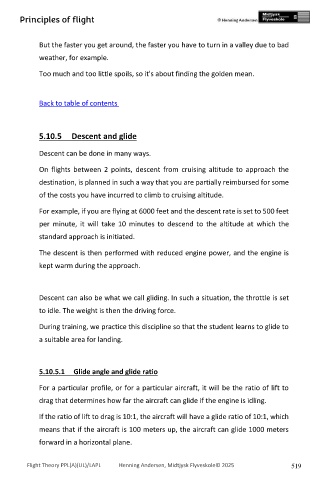Page 519 - PPL-engelsk 2025
P. 519
Principles of flight
But the faster you get around, the faster you have to turn in a valley due to bad
weather, for example.
Too much and too little spoils, so it's about finding the golden mean.
Back to table of contents
5.10.5 Descent and glide
Descent can be done in many ways.
On flights between 2 points, descent from cruising altitude to approach the
destination, is planned in such a way that you are partially reimbursed for some
of the costs you have incurred to climb to cruising altitude.
For example, if you are flying at 6000 feet and the descent rate is set to 500 feet
per minute, it will take 10 minutes to descend to the altitude at which the
standard approach is initiated.
The descent is then performed with reduced engine power, and the engine is
kept warm during the approach.
Descent can also be what we call gliding. In such a situation, the throttle is set
to idle. The weight is then the driving force.
During training, we practice this discipline so that the student learns to glide to
a suitable area for landing.
5.10.5.1 Glide angle and glide ratio
For a particular profile, or for a particular aircraft, it will be the ratio of lift to
drag that determines how far the aircraft can glide if the engine is idling.
If the ratio of lift to drag is 10:1, the aircraft will have a glide ratio of 10:1, which
means that if the aircraft is 100 meters up, the aircraft can glide 1000 meters
forward in a horizontal plane.
Flight Theory PPL(A)(UL)/LAPL Henning Andersen, Midtjysk Flyveskole© 2025 519

